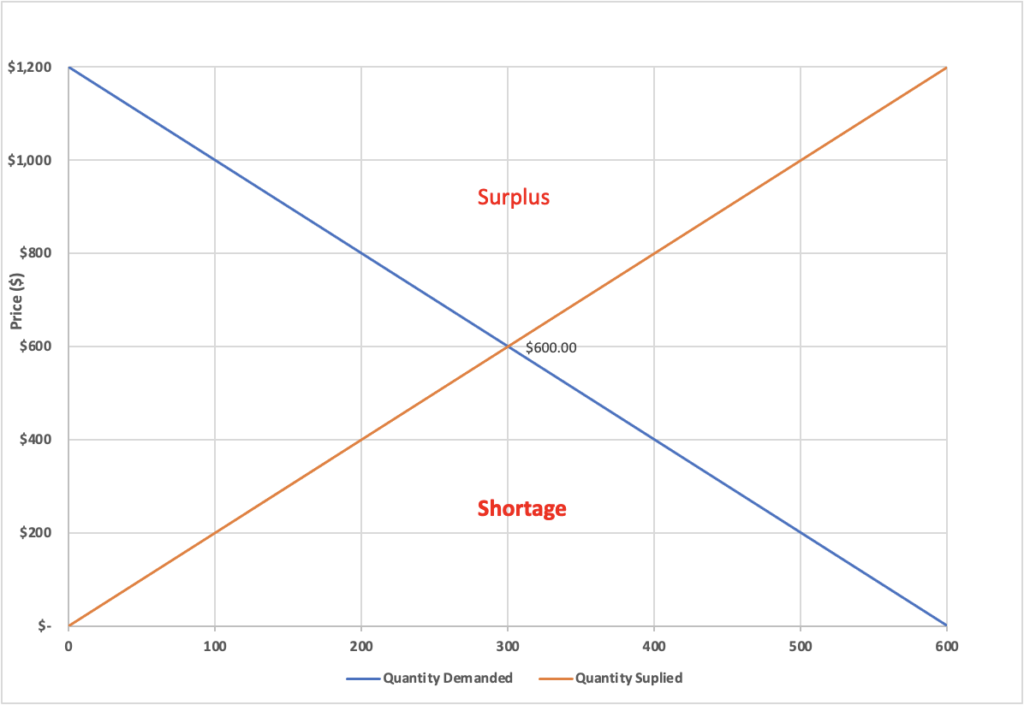Rent control won’t address the root cause of the housing crisis
In the market, prices are determined by the actions of buyers and sellers. In economics, this process is illustrated by the demand-supply curve. The demand curve has a downward slope because consumers buy less of a product when the price rises. The supply curve is upward sloping because sellers will increase their supply when the prices are going up.
Where the demand and supply curves meet is called the equilibrium, also known as the market-clearing price. This is the price at which the supply for goods in the market wholly satisfies the demand for goods and everyone is satisfied.
The rental market is the same way. In the graph below, for example, at $600 the number of units supplied equals those demanded thereby the market is cleared. At any price higher than $600, however, the quantity supplied is more than the quantity demanded, which leads to a surplus of housing units. And at any price less than $600, the quantity of units demanded is higher than the supply, which leads to a shortage.
The market clears a shortage or surplus by using price as a signaling mechanism. During a shortage, competition between renters pushes the price up which signals to landlords that there is a profit to be made if they put more units on the market. And during surplus, landlords compete for renters which pushes the price down forcing some landlords to take their units out of the market. The market, therefore, is always in a state of flux, with renters and landlords reacting to prices to bring the market to a state of equilibrium.

High and rising housing prices are a sign of shortage
Historically, rent control measures have mainly shown up in areas facing rising housing costs due to a shortage of supply. In 1593, for example, Jews living in Rome — who at the time were forbidden from owning property and could only rent in the ghetto — were banished from all but three of the Papal States. They flocked to the ghettos of Rome and Ancona, causing rents to rise disproportionately in those ghettos compared to other regions. This resulted in Pope Clement freezing rents to protect Jews from their Christian landlords.
Likewise, when Lisbon enacted rent control in 1755, it was only after a great earthquake had
destroyed one-third of the city, which slashed the city’s housing stock leading to high prices.
And like most European countries that adopted rent control during the interwar period, Washington D.C and New York — the earliest cities to adopt rent control in the U.S. — were pushed by housing shortages that had come about due to the events surrounding World War I.
So, to say the least, the Twin Cities region is not facing a novel problem. The cost of housing is high and rising because there is not enough supply to satisfy demand. The few units available are being bid up quickly due to excessive demand, causing prices to go up.
Evidence from the Metropolitan Council shows that while the housing supply has grown, it has lagged population growth. Between 2010 and 2017, for instance, the Twin Cities added 83,091 households (a growth rate of 7.4 percent) and only 63,604 new housing units (a growth rate of 5.4 percent) — a shortfall of 19,487 units.
And compared to other regions, the Twin Cities region has had the 4th highest housing growth shortfall among 12 peer metros between 2010 and 2020. Accordingly, rent control will only treat the symptom, not the root cause of high housing prices.

Lawmakers should focus on increasing housing supply to address the housing crisis
Research heavily indicates that adding new housing — even at market rates — pushes vacancy rates up thereby driving prices down as renters have more units to compete over. This phenomenon is something that we witnessed during the pandemic when high and rising vacancy rates lowered rents in many cities. In San Francisco, for example, rents were down by as much as 45 percent for one-bedroom apartments between March 2020 and 2021.
In the Twin Cities, the vacancy rate in Q3 2020 was up by 3.1 percent compared to
Q3 of 2019, causing rents to decline by 2.1 percent. While rents have started to rise back up, the negative relationship between vacancy rates and rent prices, as shown in figure 2 below, is an illustration that increasing housing supply pushes prices down or at the very least prevents prices from rising excessively.

Currently, the Twin Cities have some of the lowest vacancy rates in the nation a signal that housing supply is lagging demand. And if that rent continues, housing costs will continue to tick up.
Policymakers need to focus on increasing the housing supply, in order to address the affordable housing crisis. They can do this by removing impediments to housing supply, namely burdensome permitting requirements, land use regulations, zoning rules, environmental building codes as well as excessive fees. Excessive fees and regulations delay construction projects and add tens of thousands of dollars to the cost of housing development in the Twin Cities — costs that are ultimately passed down to consumers.